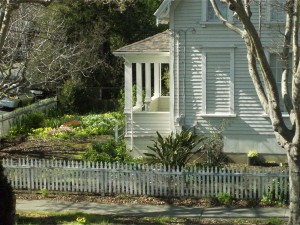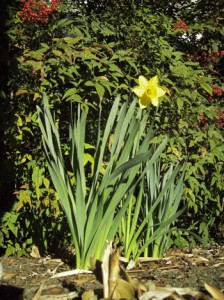Driving over the high point of the Dumbarton Bridge at the end of the day yesterday, I saw the Bay area at its most beautiful. The light rain had stopped. The land was green, and looked greener still because the light was diffused through the cloud cover. The dikes around the old salt ponds were green, and the water they contained ranged from silver to black depending on the thickness of the clouds above. And the hills of the East Bay were incredibly green, their low summits invisible in the low-hanging clouds.
Category: Bay area, Calif.
Two San Francisco scenes
I took BART into the city, and happened to arrive at the Powell BART station just as the San Francisco St. Patrick’s Day parade was passing by. People in the Bay area make a big deal about how the San Francisco St. Patrick’s Day parade is one of only three in the country to allow GLBTQ people to march. But the big deal for me was that many of the spectators topped off their bright green outfits with orange-and-black Giants baseball caps. Where I come from, you do not wear orange on St. Patty’s Day.
Overheard in a restaurant: …he wasn’t the best man, but he was going to stand right next to the best man. Well, it turns out he couldn’t hold his liquor. He barfed all over himself five minutes before the wedding started. All down his front. [The best man] took him into the bathroom and cleaned him up, and he looked fine except he had little bits of toilet paper all over him. He smelled pretty funky. But he made it through the ceremony OK.
Spring
One of the houses near where we live is a modest but lovely clapboard house with gingerbread trim, over a hundred years old (that’s really old for a house on the Peninsula), and still occupied by descendants of the family who built it. In front of the house is one of my favorite spring gardens in town; it’s not a formal garden but rather almost looks like the flowers just sprung up on their own; and at the moment, this garden is at its peak.
The garden is attractive from the sidewalk, looking at it over the white picket fence, but then you don’t really see the house. I managed to find a place where I could look down and see both the garden and the house:
Spring
There was just enough rain for Carol to keep her umbrella up. It was dark and cool and quiet as we walked along, the only sound coming from the occasional car hissing by along the wet pavement. We walked through a place where some plants hung low and dark over the sidewalk, and suddenly we were enveloped in the heavy perfume of some unseen blossoms. In two steps we were past it, and in another step it was gone and I couldn’t smell it any more.
Snow on the mountains
On the drive down to Palo Alto, there’s an overpass from which you can see the range of mountains south of San Jose. The highest peaks were still white today from the snow that fell early in the week. Today’s San Francisco Chronicle reported that up to eight inches fell on Mount Diablo (elev. 3,864 ft.), eastwards across the bay from us.
And the Chronicle reports that meteorologists say there’s a possibility that the Alaskan storm now heading southward could possibly deliver snow at sea level over the weekend. It probably won’t happen, but what if it does? — If it does snow, I’ll try to get a photo of snow on the orange tree in our back yard, which still has ripe oranges on it.
Spring: not quite here yet
It seemed like there was a lull in the rain, so Carol and I walked over to the neighborhood supermarket to buy some dinner. On the way back home, the chilly damp wind blew fine raindrops at us. “It’s cold,” said Carol. “It can’t be more than forty degrees,” I said.
When we got back, I checked the weather forecast: it’s supposed to dip down into the thirties tonight in San Mateo; there’s a possibility of snow down to the two thousand foot level tonight and tomorrow, and there’s even been a report of snow on Grizzly Summit in the Berkeley Hills, which is a mere 1,750 feet high. We won’t get any snow down where we live, but if the fog lifts tomorrow we might be able to see snow on the mountains across the bay.
1 comment lost.
Spring
The car looked like it had a dusting of very fine snow on it this morning, though it was nowhere near cold enough for snow (and snow happens only once every fifteen years or so around here anyway). When I got closer to the car, I realized that the dusting had a yellowish cast to it, and it was coarse pollen that had clumped so that it looked like snow. This morning I woke up with a headache, and a general feeling of lassitude, and when I saw all that pollen I knew that it wasn’t some imaginary malady — it was hay fever.
Last year, I blamed the acacias, but a fellow hay fever sufferer told me that the brilliant yellow blossoms of the acacias are not to blame. The acacias bloom at the same time as the pines and some of the oaks, and their bright yellow blossoms are far more noticeable than the discreet green and brownish blossoms of the pines and oaks, so we blame them for our hay fever. But the acacias do not produce anything like the quantity of pollen that the pines and oaks pump out.
Some parts of the Bay Area got heavy rain today; up near Danville, I heard that the rains were so heavy they washed out part of a major freeway. But we have had no heavy rains here in Palo Alto, nothing to wash the air of all this pollen.
Lunar New Year
We were in San Francisco this evening, and headed into Chinatown for dinner. We had forgotten that the Lunar New Year celebrations are still going on.
Walking down Grant Street, we ran into some dragons who guarded by men wearing bright yellow t-shirts emblazoned with the name of a local kung fu studio, and who were surrounded by tourists with cameras and cellphones. Someone set off lots of firecrackers; the smoke filled the street.
There’s a Chinese diner we like on Washington Street, and we went there to get some congee. But even there we unwittingly came across new year activities. Several tables at the diner were taken up with contestants for the Miss Chinatown pageant.
Thanks to Carol for this photo.
Spring in Palo Alto
Today was sunny and warm, almost warm enough for us to hold a committee meeting outdoors at lunch time. The apple trees at the school next door are white with blossoms, a couple of early California poppies are providing little spots of color along Charleston Road in front of the church, and I found this daffodil in full bloom outside the Main Hall.
Quite a contrast from the news we’re hearing from the eastern part of the United States, where buildings are collapsing under the weight of a huge amount of snow. (Personal to relatives and friends back east: yes, we do have an empty bed in our apartment if you want to escape winter for a few days and enjoy spring here.)
Excellent online biography of Sophia Fahs
Talbot School of Theology in La Mirada, California, is close to completing a massive project: a Listing of Religious Educators, capsule biographies of some 160 key figures in Protestant, Catholic, and Orthodox religious education.
A quick scan seems to reveal that just one Unitarian Universalist religious educator makes it onto the list: that person is Sophia Fahs. The capsule biography of Fahs, written by Lucinda A. Nolan, Assistant Professor of Religious Education and Catechetics, Catholic University of America, Washington, D.C., is well worth reading. Of particular interest is Nolan’s careful and concise summary of Fahs’s theological development; through her curriculum books, Fahs had a major theological influence on Unitarian Unviersalism in the middle third of the last century, so her theological development had a significant impact on Unitarian Universalism’s theological development.
In addition to the capsule biography, Nolan provides an excellent bibliography, and offers several interesting excerpts from Fahs’s many books and articles. Many of the things Fahs said continue to be relevant today, such as this excerpt from Fahs’s last article, published in 1971:
“I believe that during the past as well as today Christian churches have been neglecting the children, even though Sunday Schools have been growing in size and equipment; and few theological seminaries give the education of the ministers to children their whole-hearted interest and respect…. At present it takes a very strong purpose and a willingness to sacrifice prestige for a man or a woman to enter the field of the religious education of the young. Ministers in preparation should be helped to feel more keenly the critical importance of the children.”
Since Fahs’s day, Unitarian Universalism has become a post-Christian religious body. Yet as someone who has moved from parish ministry to education ministry, I can attest to the fact that what Fahs said then remains true today: Unitarian Universalist ministers who start working with children and teenagers move down in the ministerial pecking order; and seminaries still do not adequately emphasize the critical importance of children and teenagers.
Link to the Fahs capsule biography.




